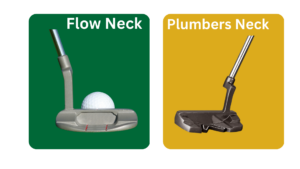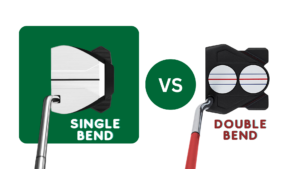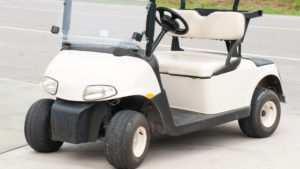Are chipping putters legal? This is a question that many golfers have asked themselves, especially when they’re just starting out. Chipping putters are becoming more and more popular on the course these days as players look for new ways to improve their game. But before you invest in one of these specialized clubs, it’s important to know what the rules say about them. Are chipping putters allowed by law or not?
In this blog post, we’ll take an in-depth look at all aspects of chipping putters – from legality to types available and how to choose the right club for your game. Let’s get started.

Table of Contents:
- Chipping Putters: What You Need to Know
- Why use a chipper?
- Chipping Putters vs Traditional Putters
- Are Chipping Putters Legal?
- Benefits ofUsing a Chipping Putter:
- Rules and Regulations for Golfers
- USGA Rules on Clubs and Equipment:
- Local Course Regulations on Clubs and Equipment:
- Professional Golf Tour Regulations on Clubs and Equipment:
- Amateur tournaments
- Types of Chipping Putters Available
- Traditional Blade-Style Putters:
- Mallet-Style Putters with Heel-Toe Weighting Technology
- High Moment of Inertia (MOI) Putters with Perimeter Weighting Technology
- Traditional Blade-Style Putters:
- How to Choose the Right Chipping Putter for Your Game
- Our favorite golf chippers
- FAQs in Relation to Are Chipping Putters Legal
- Conclusion
Chipping Putters: What You Need to Know
Chipping Putters are a type of golf club specifically designed for short-distance shots. They are typically shorter than traditional putters and have more loft, which helps the ball to get airborne quickly. Chipping putters also usually feature heavier heads and thicker shafts that provide more stability on off-center hits.

Why use a chipper?
You start questioning “are golf chippers legal or not”, Don’t worry, it’s legal to to use. Besides, using a chipper can be a valuable addition to any golfer’s game, particularly when it comes to the short game. Chippers are designed to help golfers make accurate chip shots, which can help reduce the number of strokes it takes to get the ball in the hole.
Chippers can help professional golfers achieve a consistent shot every time, and they are versatile clubs that can be used in a variety of situations. The short game is where many golfers struggle the most, and a chipper can be an effective tool for improving your short game. By using a chipper, you can increase your confidence and reduce the number of strokes it takes to get the ball in the hole. You will need a chipper club to take the putting stroke. The lob wedge and sand wedge are good ones if you adjust your loft with your height.
Chipping Putters vs Traditional Putters

The design of chipping putters varies slightly from traditional putters. They typically have a larger, more rectangular head with less loft than a standard putter. The shaft is also shorter, allowing for more control and precision when chipping.
One of the most significant differences between chipping putters and traditional putters is the way they are used. While a traditional putter is designed to roll the ball along the green, chipping putters are used to lift the ball off the ground and carry it a short distance through the air before landing it on the green.
Are Chipping Putters Legal?
Yes, chipping putters are legal according to USGA rules as long as they conform to certain specifications such as length (maximum 35 inches) and weight (maximum 1 pound). Local course regulations may vary so it’s best to check with your local pro shop before using one on the course.
Professional tours such as PGA Tour or European Tour may also have their own set of regulations regarding legal golf clubs used in golf competition play so make sure you know what those are if you plan on playing competitively at any level. But keep in mind, you are not allowed to use your chipper with a putter grip.
Benefits of Using a Chipping Putter:
One major benefit of using a chipping putter is its ability to get the golf ball airborne quickly from tight lies or difficult spots around the green without having to take too much backswing like you would with an iron shot or full-swing wedge shot.
This can be especially helpful when trying to hit over bunkers or other obstacles near the pin since it allows you to reduce risk while still getting enough distance out of your shot without having too much spin on it once it lands on the green surface itself.
Additionally, because these golf clubs tend to be lighter in weight compared with regular irons or wedges, they can be easier for some players who struggle with fatigue due to heavy swings during longer rounds
Rules and Regulations for Golfers
Golfers of all levels must be aware of the rules and regulations that govern their game. The USGA, local courses, professional golf tours, and amateur tournaments each have their own set of guidelines for clubs and equipment.

USGA Rules on Clubs and Equipment:
According to the United States Golf Association (USGA), players are limited to 14 clubs in their bag at any given time. Additionally, they must use conforming golf balls that meet certain specifications as outlined by the USGA.
Local Course Regulations on Clubs and Equipment:
Local courses may also have additional restrictions or requirements when it comes to clubs and equipment. For example, some courses may not allow metal spikes while others may require a specific type of golf ball or club head design. It’s important for golfers to check with their local course before playing so they can make sure they’re following all applicable rules.
Professional Golf Tour Regulations on Clubs and Equipment:
Professional golf tours such as the PGA Tour also have strict guidelines when it comes to what types of clubs players can use during competition rounds. Players are typically required to use approved drivers with specific shaft lengths as well as conforming balls with specific compression ratings or dimple patterns in order to compete legally in these events.
Amateur tournaments
An amateur tournament play often follows similar regulations regarding allowable clubs and equipment but there is usually more flexibility than what is seen at professional events due to the fact that amateurs don’t typically play for prize money or other incentives like professionals do.
However, most amateur tournaments still require participants to adhere closely to USGA rules regarding acceptable club designs or ball models used during competition rounds in order for scores from those rounds to be considered valid for handicap purposes after the tournament has concluded.
Types of Chipping Putters Available
They come in many different shapes and sizes, each with its own unique features that can make them better suited for certain types of players or playing styles.
Traditional Blade-Style Putters:
Traditional blade-style putters have been around since the game began and remain popular today. These clubs feature a classic design with a flat face and minimal offset, allowing for more control over your shot than other designs. The blades also tend to be lighter than other models, making them easier to swing faster when you need extra distance on your chip shots.
Mallet-Style Putters with Heel-Toe Weighting Technology

Mallet-style putters offer more forgiveness than traditional blades thanks to their larger head size and weight distribution technology that moves the center of gravity closer to the heel or toe depending on where it’s needed most during your stroke.
This helps reduce skidding offline as well as misdirection caused by improper contact between clubface and ball at impact.
High Moment of Inertia (MOI) Putters with Perimeter Weighting Technology

High MOI putters use perimeter weighting technology which places additional weight around the edges of the clubhead, creating an even higher level of stability at impact while still maintaining feeling throughout your stroke.
This makes these clubs ideal for players who struggle with accuracy due to excessive wrist action during their swings or those who simply want added confidence when chipping from tight lies near hazards such as bunkers or water hazards.
How to Choose the Right Chipping Putter for Your Game

Choosing the right chipping putter for your game can be a daunting task. There are so many different types of putters available, and each one has its own unique features that can help you improve your game. To make sure you get the most out of your purchase, it’s important to consider your skill level and playing style when selecting a chipping putter.
- When considering your skill level and playing style, ask yourself what type of golfer you are. Are you an experienced player who needs more accuracy with their short shots? Or do you need more forgiveness on off-center hits? Knowing this will help narrow down which type of chipping putter is best suited for your game.
- Once you have identified what kind of golfer you are, it is important to evaluate the different types of chipping putters available in order to determine which one would work best for your swing. Traditional blade-style putters offer great feel and control but lack forgiveness on off-center hits; mallet-style putters with heel-toe weighting technology provide better accuracy; high moment inertia (MOI) models with perimeter weighting technology give golfers maximum stability; specialty chipping putters come with unique features such as adjustable weights or alignment aids that may benefit certain players depending on their individual preferences.
- The next step is to test out different models at the driving range or practice green before making a final decision. This allows golfers to experience how each model feels in their hands while also getting feedback from other players about their experiences using various brands and styles of clubs. Additionally, reading reviews from other golfers online can provide helpful insight into which club might be right for them based on performance ratings and customer satisfaction levels reported by real users who have tried them out firsthand.
Our favorite golf chippers
Here is the list of the best golf chippers we have used in our plays. These are awesome ones if you have any of them in your golf bag. But you know, personal preferences change from person to person.
- Odyssey X-Act Tank Chipper
- Pinemeadow Golf Excel EGI Chipper
- Cleveland Golf Smart Sole 3.0 Chipper
- Ray Cook Golf- Silver Ray Chipper
By taking these steps into consideration when choosing a new chipping putter, golfers will be able to find the perfect club that fits both their budget and playing style; ensuring they get maximum enjoyment out of every round.
FAQs in Relation to Are Chipping Putters Legal
Why are golf chippers frowned upon?
Golf chippers are frowned upon because they can be difficult to control and don’t always provide the desired result. Chipping is a delicate shot that requires precision, and golfers often find it difficult to get the golf ball close enough to the hole with a chipper. Additionally, chippers require more of an up-and-down motion than other clubs, which can make them harder for some players to use effectively. Finally, many golfers believe that using a putter from off the green is preferable in most cases as it provides greater accuracy and consistency when trying to get close to the pin.
Are chippers banned in golf?
No, chippers are not banned in golf. Chippers are a type of club that is designed to help golfers hit short shots around the green. They have a wide sole and lofted face which makes them easier to use than other clubs when playing from tight lies or bunkers. Chipping can be an effective way to get close to the hole without using your putter, making it an important part of any golfer’s arsenal. Chippers are legal for use in golf, so long as they conform to the rules of the game.
Is a golf chipper USGA approved?
Yes, chippers are USGA approved. A chipper golf club designed to help golfers chip the golf ball onto the green from short distances. The USGA has established rules and regulations for all types of clubs, including chippers, in order to ensure fair play and consistent performance across all courses. Chippers must conform to certain specifications such as size, weight, loft angle, and overall design in order to be approved by the USGA.
Are two-way chippers legal in golf?
No, two-way chippers are not legal in golf under the rules of golf established by the United States Golf Association (USGA) and the Royal and Ancient Golf Club of St. Andrews (R&A). According to the rules, a golf club must have only one striking face, and a two-way chipper has two striking faces, which makes it illegal for use in competition or for posting a handicap. Golfers who use an illegal club can be disqualified from a tournament or penalized under the rules of golf.
Conclusion
Chipping putters are legal for golfers to use as long as they abide by the rules and regulations set forth by their local governing body. The type of chipping putter you choose should depend on your skill level and playing style. With so many options available, it can be difficult to decide which one is right for you. However, with a little research and practice, you can find the perfect chipping putter that will help improve your game. Now the debate is ending on “Are chipping putters legal or not”.






